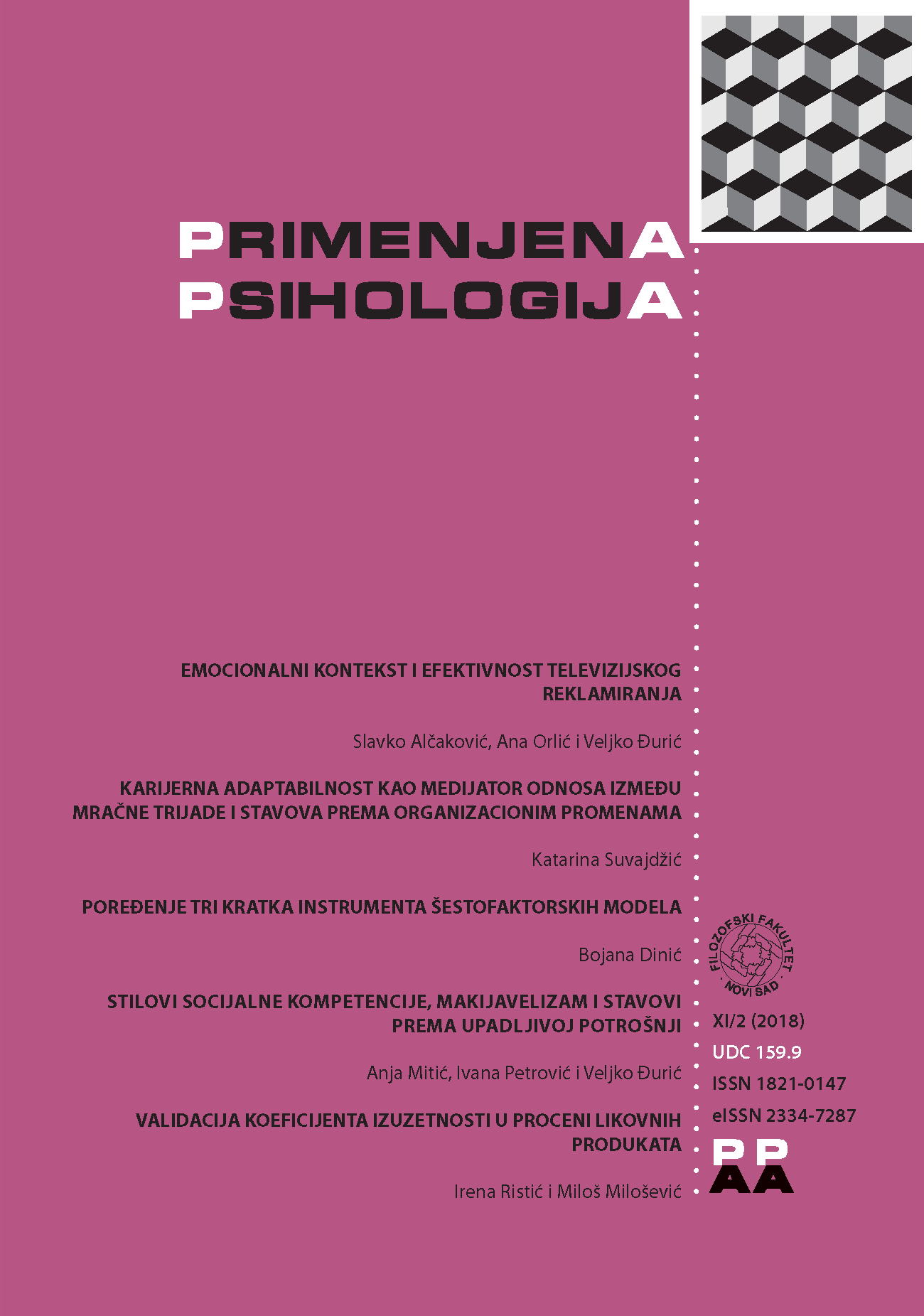EMOTIONAL CONTEXT AND EFFECTIVENESS OF TV ADVERTISING
DOI:
https://doi.org/10.19090/pp.2018.2.155-170Keywords:
emotional context, ad, effectiveness, media planningAbstract
This study examined the impact of emotional context on effectiveness of TV commercials (TVCs). In two experiments, participants were exposed to either emotionally positive or emotionally negative stimuli before watching a TVC. The effectiveness of the TVC was measured by 4 indicators: Ad recall, attitude toward the ad (Aad), attitude toward the brand (Ab), and purchase intent (PI). Results of Experiment 1 revealed that participants who were pre-exposed to a positive emotional context had a more positive Aad, Ab and a higher PI, when compared to those who were pre-exposed to a negative emotional context. Experiment 2 demonstrated that pre-exposure to the positive emotional context was associated with more positive Ab and a higher PI, while preexposure to the negative emotional context led to more negative Aad. In both experiments there was no indication of the influence of the emotional context on Ad recall. However, data from Experiment 2 suggested that both positive and negative emotional contexts positively affected ad recognition, when compared to an emotionally neutral situation. In conclusion, our findings advocate the importance of emotional context in which TVCs are broadcasted to the general public, a fact that has been vastly neglected so far by media planners.
Metrics
References
Baron, R., & Sissors, J. (2010). Advertising media planning. New York: McGraw Hill Professional.
Bellman, S., Rossiter, J. R., Schweda, A., & Varan, D. (2012). How coviewing reduces the effectiveness of TV advertising. Journal of Marketing Communications, 18(5), 363–378. doi:10.1080/13527266.2010.531750
Bradley, M. M., & Lang, P. J. (1999). International affective digitized sounds (IADS): Stimuli, instruction manual and affective ratings (Tech. Rep. No. B-2). Gainesville, FL: The Center for Research in Psychophysiology, University of Florida. Cohen, J. B., Pham, M. T., & Andrade, E. B. (2008). The nature and role of affect in consumer behavior. In C. P. Haugtvedt, P. M. Herr, & F. R. Kardes (Eds.), Hand-
book of Consumer Psychology (pp. 297–348). New York: Psychology Press.
Coulter, K. S. (1998). The effects of affective responses to media context on advertising evaluations. Journal of Advertising, 27(4), 41–51. doi:10.1080/009133 67.1998.10673568
De Pelsmacker, P., Geuens, M., & Anckaert, P. (2002). Media context and advertising effectiveness: The role of context appreciation and context/ad similarity. Journal of Advertising, 31(2), 49–61. doi:10.1080/00913367.2002.1067 3666
De Pelsmacker, P., Geuens, M., & Van den Bergh, J. (2010). Marketing communications: A Europian perspective. Essex: Pearson education.
De Pelsmacker, P., Geuens, M., & Vermeir, I. (2004). Ad and brand recognition in radio spots. International Journal of Market Research, 46(4), 465–477. doi:10.1177/147078530404600402
Forgas, J. P. (1995). Mood and judgment: The affect infusion model. Psychological Bulletin, 117(1), 39–66. doi:10.1037/0033-2909.117.1.39
Goldberg, M. E., & Gorn, G. J. (1987). Happy and sad TV programs: How they affect reactions to commercials. Journal of Consumer Research, 14(3), 387–403. doi:10.1086/209122
Gorn, G., Pham, M. T., & Sin, L. Y. (2001). When arousal influences ad evaluation and valence does not (and vice versa). Journal of Consumer Psychology, 11(1), 43–55. doi:10.1207/S15327663JCP1101_4
Kelley, L., Jugenheimer, D. W., & Sheehan, K. (2015). Advertising media planning: a brand management approach. New York: Routledge.
Lang, P.J., Bradley, M.M., & Cuthbert, B.N. (2008). International affective picture system (IAPS): Affective ratings of pictures and instruction manual (Technical Report A-8). University of Florida, Gainesville, FL.
Lee, A. Y., & Sternthal, B. (1999). The effects of positive mood on memory. Journal of Consumer Research, 26(2), 115–127. doi:10.1086/209554
MacKenzie, S. B., Lutz, R. J., & Belch, G. E. (1986). The role of attitude toward the ad as a mediator of advertising effectiveness: A test of competing explanations. Journal of Marketing Research, 23(2), 130–143. doi:10.2307/3151660
Malthouse, E. C. & Calder, B. J. (2010). Media placement versus advertising execution. International Journal of Market Research, 52(2), 217–230. doi:10.2501/ S1470785309201181
Mehta, A. (2000). Advertising attitudes and advertising effectiveness. Journal of Advertising Research, 40(3), 67–72. doi:10.2501/JAR-40-3-67-72
Mehta, A., & Purvis, S. C. (2006). Reconsidering recall and emotion in advertising. Journal of Advertising Research, 46(1), 49–56. doi:10.2501/ S0021849906060065
Murry Jr, J. P., Lastovicka, J. L., & Singh, S. N. (1992). Feeling and liking responses to television programs: An examination of two explanations for media-context effects. Journal of Consumer Research, 18(4), 441–451. doi:10.1086/209272
Pavelchak, M. A., Antil, J. H., & Munch, J. M. (1988). The Super Bowl: An investigation into the relationship among program context, emotional experience, and ad recall. Journal of Consumer Research, 15(3), 360–367. doi:10.1086/209172
Poels, K., & Dewitte, S. (2006). How to capture the heart? Reviewing 20 years of emotion measurement in advertising. Journal of Advertising Research, 46(1), 18–37. doi:10.2501/S0021849906060041
Poncin, I., & Derbaix, C. (2009). Commercials as context for other commercials. Journal of Advertising, 38(3), 33–50. doi:10.2753/JOA0091-3367380303
Price Waterhouse Coopers (2016). IAB internet advertising revenue full year 2015. Retrieved from: http://www.iab.com/wp-content/uploads/2016/04/ FY2015-PwC-Matt-Hobbs-Presentation-Global-Trends.pdf
Schwarz, N., & Clore, G. L. (1983). Mood, misattribution, and judgments of well-being: informative and directive functions of affective states. Journal of Personality and Social Psychology, 45(3), 513–523. doi:10.1037/0022-3514.45.3.513
Singh, M., Balasubramanian, S. K., & Chakraborty, G. (2000). A comparative analysis of three communication formats: advertising, infomercial, and direct experience. Journal of Advertising, 29(4), 59–75. doi:10.1080/00913367.2000
.10673624
Till, B. D., & Baack, D. W. (2005). Recall and Persuasion: does creative advertising matter? Journal of Advertising, 34(3), 47–57. doi:10.1080/00913367.2005.1 0639201
Walker, D., & Dubitsky, T. M. (1994). Why liking matters. Journal of Advertising Research, 34(3), 9–19.
Watson, D., Clark, L. A., & Tellegan, A. (1988). Development and validation of brief measures of positive and negative affect: The PANAS scales. Journal of Personality and Social Psychology, 54(6), 1063–1070. doi:10.1037/00223514.54.6.1063







